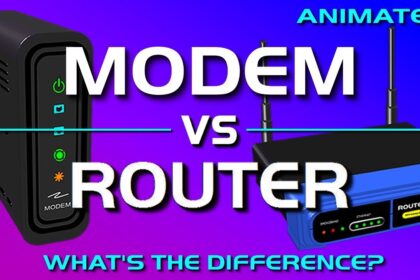Modem vs Router – What’s the difference?

Hello everyone. In this article we’re going to talk about the distinctions between a Modem vs Router Because a lot of parties actually think that a modem and a router are the same thing But “theyre not”. They are different with two separate personas on a system So I’m going to explain the difference between the two Now if you miss internet inside your home or business, you have to have a modem. A modem is what fetches the internet into your home or business. A modem builds and maintains a dedicated connection to your internet service provider to give you access to the internet. Now the reason why you have to have a modem is because of the two different types of signals that are used on personal computers and on the internet.A computer merely reads digital signals, while signals out on the internet are analog. As analog data comes in from the internet, the modem demodulates the incoming analog signals into a digital signal so that a computer can understand it. And a modem too modulates outgoing digital signals from personal computers into an analog signal as it runs out on the internet. And this is where we get the word ‘modem ‘. The command modem represents modulator demodulator which is exactly what a modem does. It modulates outgoing data from a computer and demodulates incoming data regarding the internet Now a router comes in after the modem. Now there are different types of routers There are routers that are used in businesses and larger make-ups And there are smaller routers that are used in homes and small businesses But they mostly do the same thing. But for this article we’re going to use the small position/ home office router that most of us are familiar with Now a router is what roadway or proceeds your internet connection to all of your maneuvers in your residence or business. It addresses it to all of your computers, tablets, telephones and so on so that those devices can access the internet A typical small role/ home office router, like this one here, will have a built-in switch with variou ports so that you can connect multiple machines use an ethernet cable acquaintance And the committee is also affairs as a wireless access target so that wireless machines such as tablets and laptops can have internet access Now technically you really don’t need a router if you merely demand one of your maneuvers to access the internet.You can merely plug that device’s system cable directly into the modem, and then you’ll be able to access the internet. Nonetheless, like most the house and business you’re going to have various manoeuvres that need access to the internet, and that’s where you would need a router. There are also different types of modems. Two of the most common categories are cable and DSL modems. So depending upon what type of internet you’re going to use, you need to use the correct type of modem. Cable modems are connected to your residence abusing a coax cable. Cable is typically provided by the same company that provides you with cable television such as Comcast, which is one of the largest providers in the United States.And DSL modems are connected exerting a ordinary phone line. DSL is provided by corporations such as AT& T, which is the largest provider in the U.S. Now a lot of days your internet service provider when they send you a modem, or if you were to buy one at the storage, the modem might be a modem/ router combination. So it will be a modem with a built-in wireless router in one physical manoeuvre, such as this one here So here is an example of several different networks on how they connect to the internet. For speciman, this network here on the left is using a cable modem.And it’s using a small office/ home office router so that its computers and the tablet can have internet access. On a underside we have another network. And this network is using a DSL modem. And it’s also consuming a small office/ home office router so that its computers, the laptop, and the tablet can access the internet. The network here on the right is an example of a business network. And it’s using a cable modem, and it’s using a business router so it can connect its computer hardware and its server. And ultimately we have the network here on top. And this only has one device that needs internet access. So it doesn’t need to use a router. It can just immediately connect to the modem because only one design needs internet access.Now if you’re wondering how hubs and buttons are addressed to routers and modems, especially if you watched my other article where I justified the differences between hubs, switchings, and routers, well keep in mind that most routers will have a built in switch inside of them. So there’s no need to have a switching if you already have a router that has a switch built into it. So for example a router like this may have a four port integrated substitution so that you can connect four Ethernet cables for your cabled maneuvers. So the only era may need to add a switch to this network is if you needed more cabled acquaintances for your manoeuvres. So you can really connect a be changed to your router and then add more connections to the switch. So time to clear things up even more, over here we have the internet with all of its routers Then because the internet is routed into this private network, it firstly contacts the modem, then it goes from the modem to its router with its integrated switch and then it’s passed to all of its computers . .



